| Solar eclipse of June 8, 1918 | |
|---|---|
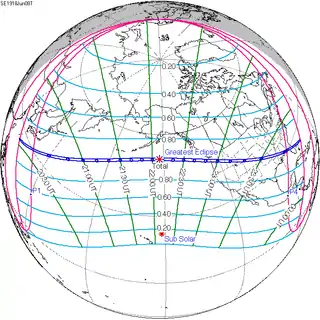 Map | |
| Type of eclipse | |
| Nature | Total |
| Gamma | 0.4658 |
| Magnitude | 1.0292 |
| Maximum eclipse | |
| Duration | 143 sec (2 m 23 s) |
| Coordinates | 50°54′N 152°00′W / 50.9°N 152°W |
| Max. width of band | 112 km (70 mi) |
| Times (UTC) | |
| Greatest eclipse | 22:07:43 |
| References | |
| Saros | 126 (42 of 72) |
| Catalog # (SE5000) | 9324 |
A total solar eclipse occurred on Saturday, June 8, 1918. The eclipse was viewable across the entire contiguous United States, an event which would not occur again until the solar eclipse of August, 2017.
The path

The path of totality started south of Japan, went across the Pacific Ocean, passing northern part of Kitadaitō, Okinawa and the whole Tori-shima in Izu Islands on June 9 (Sunday), and then acrossed the contiguous United States and British Bahamas (today's Bahamas) on June 8 (Saturday). The largest city to see totality was Denver, although many could theoretically see it as the size of the shadow was between 70 and 44 miles (113 and 71 km) across as it traveled across America. The longest duration of totality was in the Pacific at a point south of Alaska. The path of the eclipse finished near Bermuda.[1]
Besides the path where a total solar eclipse was visible, a partial solar eclipse was visible in the eastern part of East Asia, northern part of Northern Europe, eastern part of Micronesia, Hawaii Islands, northeastern Russian Empire, the entire North America except the Lesser Antilles, and the northwestern tip of South America.
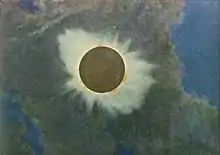
U.S. Observation team
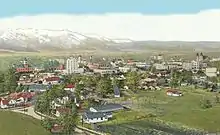
The path of the eclipse clipped Washington state, and then moved across the whole of Oregon through the rest of the country, exiting over Florida. The U.S. Naval Observatory (USNO) obtained a special grant of $3,500 from Congress for a team to observe the eclipse in Baker City, Oregon. The team had been making preparations since the year before, and John C. Hammond led the first members to Baker City on April 11.[2] The location was important, as it influenced the probability of cloud cover and the duration and angle of the sun during the eclipse. The team included Samuel Alfred Mitchell as its expert on eclipses, and Howard Russell Butler, an artist and physicist. In a time before reliable colour photography, Butler's role was to paint the eclipse at totality after observing it for 112.1 seconds.[3] He noted later that he used a system of taking notes of the colours using skills he had learned for transient effects.[3]
Joel Stebbins and Jakob Kunz from the University of Illinois Observatory made the first photoelectric photometric observations of the solar corona from their observing site near Rock Springs, Wyoming [4]
Observation
As the total eclipse approached, the team watched as clouds obscured the Sun. The clouds did clear, but during their most important observations the Sun was covered by a thin cloud; the Sun was completely visible five minutes later.[2] This was not unusual, as cloudy conditions were reported across the country, where the eclipse was also observed from the Yerkes Observatory, Lick Observatory, and Mount Wilson Observatory.[5]
Following the 1915 prediction of Albert Einstein's General theory of relativity that light would be deflected when passing near a massive object such as the Sun, the USNO expedition attempted to validate Einstein's prediction by measuring the position of stars near the Sun. The cloud cover during totality obscured observations of stars,[6] though, preventing this test of the validity of general relativity from being completed until the solar eclipse of May 29, 1919.
Related eclipses
There were two other eclipses that year. The first was a partial lunar eclipse, during which the shadow of the Earth can be seen on the Moon, and another solar eclipse that took place on December 3 over South America.[1] The other solar eclipse, however, was an annular eclipse, which occurs when the Moon has a smaller apparent diameter and therefore never fully obscures the Sun.
Solar eclipses of 1916–1920
This eclipse is a member of a semester series. An eclipse in a semester series of solar eclipses repeats approximately every 177 days and 4 hours (a semester) at alternating nodes of the Moon's orbit.[7]
| Solar eclipse series sets from 1916–1920 | ||||
|---|---|---|---|---|
| Ascending node | Descending node | |||
| 111 | December 24, 1916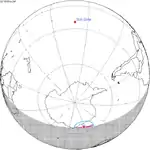 Partial |
116 | June 19, 1917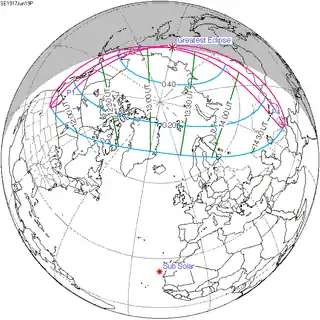 Partial | |
| 121 | December 14, 1917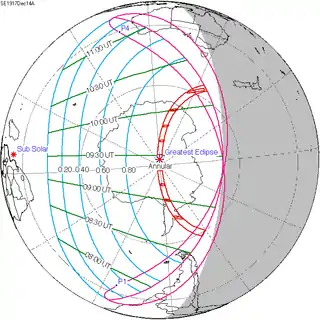 Annular |
126 | June 8, 1918 Total | |
| 131 | December 3, 1918 Annular |
136 | May 29, 1919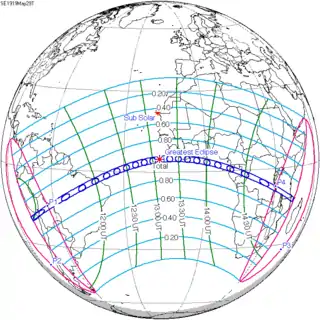 Total | |
| 141 | November 22, 1919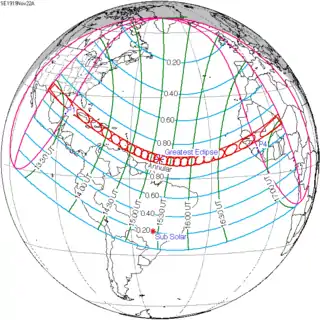 Annular |
146 | May 18, 1920 Partial | |
| 151 | November 10, 1920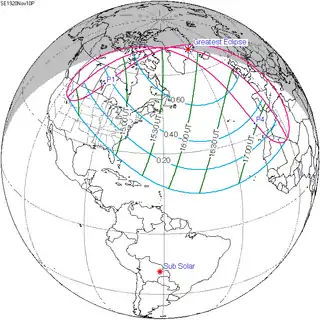 Partial | |||
Saros 126
It is a part of Saros cycle 126, repeating every 18 years, 11 days, containing 72 events. The series started with partial solar eclipse on March 10, 1179. It contains annular eclipses from June 4, 1323 through April 4, 1810, hybrid eclipses from April 14, 1828 through May 6, 1864 and total eclipses from May 17, 1882 through August 23, 2044. The series ends at member 72 as a partial eclipse on May 3, 2459. The longest duration of central eclipse (annular or total) was 6 minutes, 30 seconds of annularity on June 26, 1359. The longest duration of totality was 2 minutes, 36 seconds on July 10, 1972. All eclipses in this series occurs at the Moon’s descending node.
| Series members 42–52 occur between 1901 and 2100 | ||
|---|---|---|
| 42 | 43 | 44 |
 June 8, 1918 |
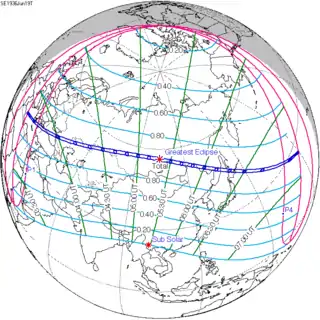 June 19, 1936 |
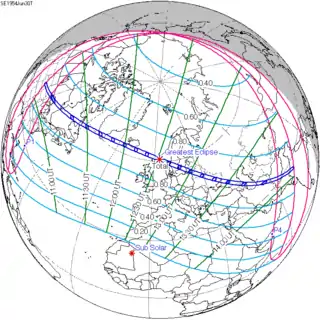 June 30, 1954 |
| 45 | 46 | 47 |
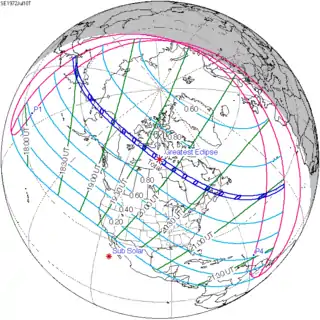 July 10, 1972 |
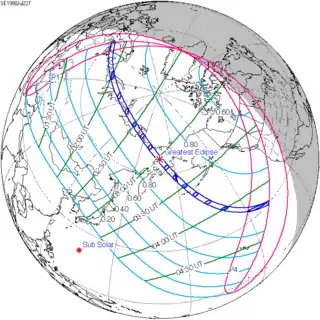 July 22, 1990 |
 August 1, 2008 |
| 48 | 49 | 50 |
 August 12, 2026 |
 August 23, 2044 |
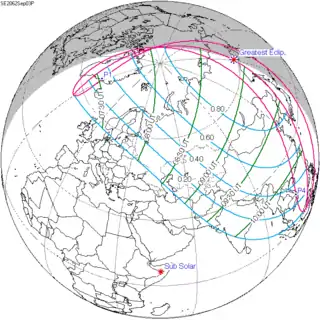 September 3, 2062 |
| 51 | 52 | |
 September 13, 2080 |
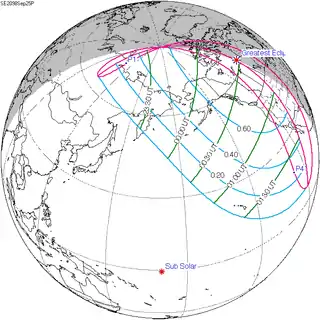 September 25, 2098 | |
Notes
- 1 2 Motherwell, R.M. (1918). "The Total Solar Eclipse, June 8, 1918". Journal of the Royal Astronomical Society of Canada. 12: 160–168A. Bibcode:1918JRASC..12..160M.
- 1 2 Hammond, J.C. (1919). "The Naval Observatory eclipse expedition, June 8, 1918". Popular Astronomy. 27 (1): 1. Bibcode:1919PA.....27....1H.
- 1 2 Lawrence, Jenny; Richard Milner (February 2000). "A Forgotten Cosmic Designer". Natural History. Retrieved 19 October 2010.
- ↑ Stebbins, Joel (1918). "The Illinois eclipse expedition to Rock Springs Wyoming". Popular Astronomy. 26: 665. Bibcode:1918PA.....26..665S.
- ↑ "Total Solar Eclipse of June 8, 1918". Nature. 102 (2553): 89–90. 3 October 1918. Bibcode:1918Natur.102...89.. doi:10.1038/102089a0.
- ↑ Siegel, Ethan (2007). "America's Previous Coast-To-Coast Eclipse Almost Proved Einstein Right", Forbes, August 4, 2017, retrieved 24 April 2022.
- ↑ van Gent, R.H. "Solar- and Lunar-Eclipse Predictions from Antiquity to the Present". A Catalogue of Eclipse Cycles. Utrecht University. Retrieved 6 October 2018.
Other links
- NASA graphic
- Eclipse of June 8, 1918. Contact print from the original glass plate negative. Lick Observatory Plate Archive, Mt. Hamilton.
- Foto and sketch of Solar Corona June 8, 1918
.jpg.webp)

